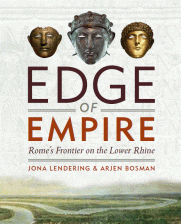Centuries before the Romans arrived in Gaul, even centuries before the Celtic culture spread over Europe, there were already people living in what is now northern France and southern Belgium. Although these people were usually farmers, there must have been traders among them too, because we are certain that already in the last phase of the Neolithicum, there were important roads. They can be recognized if you plot the burial mounds on a map; immediately, you will see that they are arranged in long lines. The people wanted to be buried along a road.
One road appears to have been of extreme importance, as people continued to be buried along it in the Bronze Age, Iron Age, and Roman Age as well. It leads from modern Amiens to Bavay, Tongeren, and Cologne – in other words, it connected the capitals of the Atrebates, Nervians, Tungrians, and Ubians, the main ethnic units of Gallia Belgica at the time of the Roman conquest. It was used by Caesar when he invaded Belgica in 57 BCE and defeated the Nervians, was used by the Fourteenth legion Gemina when it had to suppress the Batavian Revolt (70 CE), and was used in the late fourth century by Frankish warriors who left Toxandria and settled on more fertile soils.
In the Middle Ages, the road from Bavay to Tongeren was called Chaussée Brunehaut (“road of Brunhilda”), a name that is still officially used and can be found in many municipalities in northern France and southern Belgium. This Brunhilda was one of the most powerful rulers of the late sixth and early seventh century. She became the heroine of many sagas, and it is now difficult to see behind the legend and find out whether she really had something to do with the streets still named after her.
The modern name Via Belgica, coined by archaeologists and planologists, is rather ill-chosen. The Romans named their roads after the men who built them: Via Appia or Strata Diocletiana. If a street has a geographic element in its name, this invariably indicates a destination, not the country it traversed (Via Labicana, Via Portuense). Via Belgica would therefore be the name of the road leading to Belgica and can never have been an indication for a road through Belgica.
That being said, the Chaussée Brunehaut or Via Belgica or whatever you prefer to call it, is an important monument. I am not certain, but it may be one of the oldest roads in the world that is still in use. You can find more information here.


 Subscribe to feed
Subscribe to feed